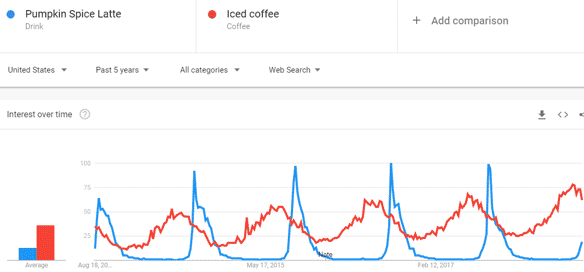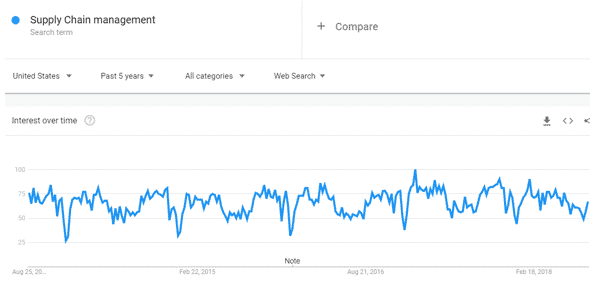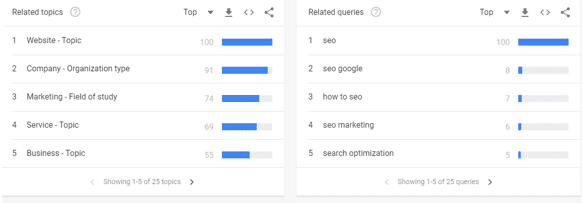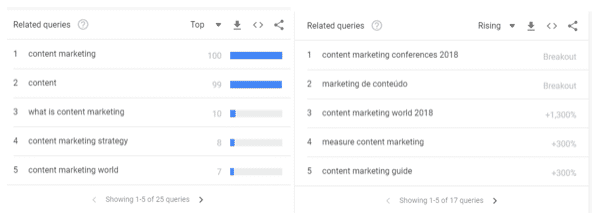I’ve always been a fan of Google Trends. At times, my fandom for the tool has even bordered on addiction, especially when a colleague introduced me to the gamified version of Google Trends, Trendquiz (clicker beware).
With Google’s recent update to the Trends tool, I felt it was an appropriate time to look at some of the ways it can be used for keyword research and to gain quick insight into what’s trending.
What Is Google Trends?
Google Trends is a helpful (and fun) tool that can lend a big hand to your SEO keyword planning efforts. If you’ve never used it before, I recommend clicking the link and checking it out right now. The fastest way to learn is by doing, right?
Google Trends allows you to enter search terms (even comparing multiple terms at once) and see its relative popularity over a period of time. The data for most terms stretches all the way back to 2004, so you can really get a complete picture for a keyword term’s entire lifespan.
As the Google Trends tool has evolved, it has become more sophisticated and allowed for more detailed visualizations for each term entered. Users now can also find related search terms, a heat map showing interest across the US (or other countries) and more.
What’s The Difference Between Google Trends And Google Keyword Planner?
Google Trends and Google Keyword Planner report very similar information. In fact, if you put a Google Trends popularity graph next to a GKP graph, they’d have a lot of similarities and follow a similar trend line. Similar, but not exactly the same.
That’s because GKP and Google Trends are tracking slightly different metrics. GKP looks at absolute search volume, while Google Trends measures relative popularity of a term. It takes that absolute search volume from GKP and then divides it by the total number of searches for all other terms for that region and span of time.
The number is then scaled between 0-100 based on how populous it is compared to all the other terms being searched. This is why Google Trends and GKP data can look similar when visualized; a high-volume term is also very popular.
How To Use Google Trends
The popularity trends and data visualizations that Google Trends provides are helpful, but, like any metric, it can be all too easy to jump to conclusions, follow insights that aren’t accurate and make mountains out of molehills.
To better ensure that you don’t accidentally trip yourself up using Google Trends, here are some tips on how to use it appropriately and what it can be used for.
Understand Search Parameters: When you enter a term to explore, Google Trends gives you four drop down menus that allow you adjust the parameters for your search.
Geography: For general SEO keyword research, choosing worldwide or even US can give you a wealth of data. But, if you want to get more specific, you can search by country or even an individual state. This is great for expanding into new locations and enhancing your local SEO efforts.
Time Frame: You can adjust the time frame of your research to span up to five years. Google Trends has data going back to 2004, but not for all terms. You can even create a custom time frame, which can be really impactful for measuring the popularity of search terms during the stretch of time that you were running a campaign or optimizing for these terms. That said, if you’re choosing a shorter time frame (a year or less) to measure the relative popularity of search terms, don’t misread a downwards turn as a decline in search volume. If you expand your search frame, you may find that it is routine seasonality.
Categories: This parameter allows you to suggest a broader subject that helps Google Trends choose the right search data to project. For example, if you’re exploring the Minnesota Twins baseball team, as a search term, you don’t want the data to be muddled by people searching for twin babies born in Minnesota. Thus, you can select “Sports” as a category and improve the accuracy of the data.
Search Type: You can specify if you want to explore queries outside of organic web searches, like image or news searches, Google Shopping data, even which YouTube searches are most popular. Each of these various search types can provide valuable insight, depending on the term and intent of your research.
Playing with these different parameters and filters allows you to look at search terms under different lenses. Sometimes, looking through the right window can yield interesting insights to help you understand now just what people are searching, but even how and why.
Compare And Contrast Keywords: One of the common ways to use Google Trends is to compare two or more terms alongside one another. In terms of keyword research, this is a great method for ranking words in order of popularity and identifying the most valuable terms relevant to your business. You may even discover terms that you didn’t realize were so frequently searched.
You can take these keywords and investigate which ones are most commonly and uncommonly being optimized for among you and your competitors. The biggest SEO wins can be found when popular search terms aren’t so popularly being leveraged by brands. Low SEO competition means there’s little-to-no effort necessary to rank well.
Locate Seasonal Keyword Opportunities: Some terms have predictable rises and falls based on the time of year. We search for sunscreen in the summer, scarves in the winter, pastels in spring and pumpkin spiced everything in fall. These are obvious insights, but what’s far less clear is the exact point in time when, for example, pumpkin spiced lattes start to shoot up in popularity. Or, when iced coffee starts to regain its search supremacy.
Not every term with these timely rises and falls are governed by actual seasons or changes in the weather. Other season terms happen for much subtler and less predictable reasons.
These can be difficult to detect with a tool like Google Trends (even then it takes a keen eye). Yet, the reward for capitalizing on them can be greater because of the subtle and less obvious nature. Fewer people are recognizing these trends, which means the opportunity is more valuable.
For instance, can you guess why “supply chain management” follows a nearly identical trend line each year, with a large dip occurring at the end of the year?
Find New, Related Queries: Studying trend lines and comparing the popularity of multiple keywords does yield a lot of information. Not to mention, it is a lot of fun, especially when you really get into the hard-hitting debates (Coke v. Pepsi, McDonald’s v. Burger King, Beyonce v. everyone).
Yet, one of the most valuable Google Trends resources requires you to scroll further down the page, until you find the ‘Related Topics’ and ‘Related Queries’ sections.
If you’re looking for inspiration for new blog content or fresh keywords, this can be a great tool. Related Topics shows you other conversations and interests that your audience may be interested in exploring, while related queries are other keywords related to the term you’ve entered.
Here’s how Google Trends breaks down the top related terms and queries to “search engine optimization:”
But, the real power is when you switch the slider from “top” related queries to “rising,” which shows breakout terms that are gaining fast popularity on Google Search. Consider the differences between top and rising queries for “content marketing:”
In most cases, the “top” related terms are obvious and things you’re already implementing into your content. The rising, breakout terms, however, may not be so clear-cut and could give way to some really good insight into the keywords that people are using right now.
You can also visit Google Trends’ homepage and find recently trending topics across all of Google. These are almost exclusively celebrities, big events taking place, breaking news topics and the like. While these trending topics may not directly relate to your business or its content, you may be able to find creative ways to parlay them into fun topic headlines.
Conclusions
Google Trends is a tool that anyone can find use out of, even if that use is just having a little fun with data trends. But, when SEOs dig a little deeper into the features and offerings of Google Trends, they can find some real insight into what and how people are using search.
By keeping your content and tactics optimized with trending terms, you can always remain in the conversation, no matter how the interests or attitudes of your target audience shifts and evolves.



